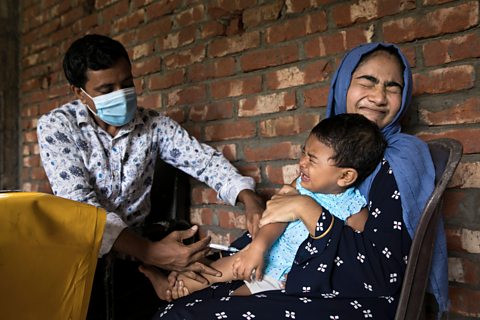Vaccination and immunisation programmes
Vaccinations and immunisations are treatments used to reduce the spread and impact of disease.
Vaccines contain weakened or inactive parts of a pathogenMicroorganism that causes disease.. When someone receives a vaccine, their body is exposed to this part of the pathogen in a safe way. The body's immune systemThe body's defence system against entry of any foreign body, including pathogens and agents such as pollen grains. The role of the immune system is to prevent disease. responds by producing antibodyA protein produced by the immune system in humans (and other animals) that attacks foreign organisms (antigens) that get into the body. to detroy the pathogen. If someone who has been vaccinated is exposed to the same pathogen, their immune system will recognise it and destroy it before infection spreads.
This can help to decrease illness and infant mortality rates and increase life expectancy.
Immunisation in Bangladesh

The government of Bangladesh began it's Expanded Program of Immunisation in 1979.
By 1985, only 1% of children in Bangladesh were immunised against measles, diphtheria and polio. Since then vaccination rates have increased hugely. In 2019, a study of children aged between 12 and 59 months found that:
- 86% were fully immunised
- about 97% of the children were immunised against tuberculosis, polio, diphtheria, pertussis and tetanus
- 88% were immunised against measles
- more children were immunised in urban areas (88.5%) than rural areas (85.1%)
Bangladesh's child mortality rate has fallen by two-thirds since 1990. Every day 12,000 fewer children under the age of five now die than in 1990. Measles deaths are down by 78% since 2000, and more than 90% of children now start primary school.
Despite this success, Bangladesh remains in the the top ten countries in the world with the highest childhood mortality. 100, 000 child deaths were recorded in 2016.